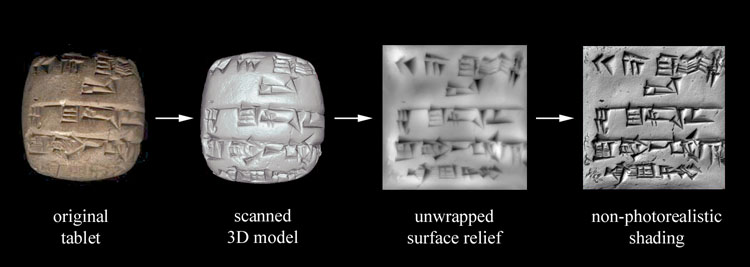
Unwrapping and Visualizing Cuneiform Tablets
Authors:
IEEE Computer Graphics and Applications
Vol. 22, No. 6, November/December, 2002, pp. 82-88.
Abstract:
Thousands of historically revealing cuneiform clay tablets, which were
inscribed in Mesopotamia millenia ago, still exist today. Visualizing
cuneiform writing is important when deciphering what is written on the
tablets. It is also important when reproducing the tablets in papers
and books. Unfortunately, scholars have found photographs to be an
inadequate visualization tool, for two reasons. First, the text wraps
around the sides of some tablets, so a single viewpoint is
insufficient. Second, a raking light will illuminate some textual
features, but will leave others shadowed or invisible because they
are either obscured by features on the tablet or are nearly aligned
with the lighting direction. We present solutions to these problems by
first creating a high-resolution 3D computer model from laser range
data, then unwrapping and flattening the inscriptions on the model to
a plane, allowing us to represent them as a scalar displacement map,
and finally, rendering this map non-photorealistically using
accessibility and curvature coloring. The output of this
semi-automatic process enables all of a tablet's text to be perceived
in a single concise image. Our technique can also be applied to other
types of inscribed surfaces, including bas-reliefs.
Available information:
-
Paper with our formatting
-
with high-res images
(PDF file, 17 MB)
-
with mid-res images
(PDF file, 12 MB)
-
with low-res images
(PDF file, 3 MB)
-
Paper as it appears in IEEE CG&A (some changes in wording from ours)
